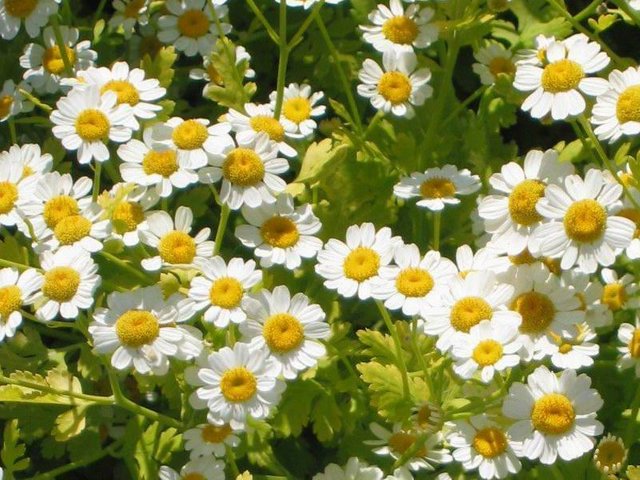Getting to Know Herbs: Feverfew
Thanks to its anti-inflammatory and vasodilating (blood vessel widening) properties, feverfew is a the chief medicinal plant in the treatment of migraines, headaches and joint pain. Extract of the leaf and flowers are harvested at the start of the flowering period.

Photo by @krnel
Feverfew is the most common name, it's also known as bachelor's buttons. The scientific botanical name is Tanacetum partheniumbut also the synonyms of Chrysanthemum parthenium and Pyrethrum parthenium. Other names include Altamisa, Chrysanthème Matricaire, Chrysanthemum praealtum, Featerfoiul, Featherfew, Featherfoil, Flirtwort Midsummer Daisy, Grande Camomille, Leucanthemum parthenium, Matricaria, Matricaria eximia, Matricaria parthenium, Partenelle, Pyrèthre Doré, Pyrèthre Mousse, Santa Maria, Tanaceti Parthenii, Tanaisie Commune.

wikimedia, CC BY 2.5
Key Points
- good treatment for headaches and migraines
- withdrawal form use can lead to headaches
- many potential side effects with prolonged or excessive use
- not considered to be effective for fever, despite it's origin and name relating to such
History
Feverfiew comes from the Latin febrifugia, meaning fever reduced. But it's no longer considered useful for reducing fevers. The earliest medicinal use is documented by herbalist physician Dioscorides as an anti-inflammatory.
Where is it found?
Feverfew is native to Eurasia, such as the the Balkan Peninsula, Anatolia and the Caucasus. But it has spread worldwide into the rest of Europe and North America. It's considered an invasive weed.
It can be found in mountain scrubs, rocky slopes, walls, waste places and as a weed in gardens.
What's it used for?
The dried flowers can be used in pastry cooking. Added to some foods, it can add an aromatic bitter taste. Teas can be made from the flowers.
Feverfew is taken orally mainly for the treatment of headaches. Other uses include irregular menstrual periods, arthritis, a skin disorder called psoriasis, allergies, asthma, ringing in the ears (tinnitus), dizziness, nausea and vomiting, difficulty getting pregnant or fathering a child (infertility), "tired blood" (anemia), cancer, common cold, earache, liver disease, prevention of miscarriage, muscular tension, bone disorders, swollen feet, diarrhea, upset stomach, and intestinal gas.
Some people use it applied to the gums for toothaches, or applied to the skin for germs, itching and prevent insect bites. It's also been used for intestinal parasites.
Are there any risks?
Short term use is safe, up to 4 months. Side effects include upset stomach, heartburn, diarrhea, constipation, bloating, flatulence, nausea, vomiting, nervousness, dizziness, headache, trouble sleeping, joint stiffness, tiredness, menstrual changes, rash, pounding heart, and weight gain. Chewing feverfew can cause mouth sores; swelling of the mouth, tongue, and lips; and loss of taste.
Pregnant women should avoid, as it might cause contractions or miscarriages. Those with bleeding disorders should also avoid, as it might slow blood clotting and increase the risk of bleeding. Also avoid for surgery. Medications that are broken down and changed by the liver can interact with feverfew. Anyone allergic to the Asteraceae/Compositae plant family should avoid, this includes plants like ragweed, chrysanthemums, marigolds, daisies, and many others.
References:
Previous posts on Getting to Know Herbs:
Lemon Balm | Hawthorn | Chickweed | Northern Bayberry | Lady's Mantle | Hyssop | Burdock | Catnip | Lavender | Yarrow | Marshmallow | Skullcap | Codonopsis (Poor Man's Ginseng) | Schisandra | Rhodiola | Canadian Goldenrod | German Chamomile | Blue Vervain | Blessed or Holy Thistle | Common Horehound | Cayenne | Ashwagandha | Gotu Kola | Common Verbana/Vervain | Holy Basil | Sweet Annie | Globe Artichoke | Butterfly Weed / Pleurisy Root | Joe-Pye Weed / Gravel Root | Valerian | Malva/Mallow | Boneset | Elecampane | Lungwort | Cramp Bark | Motherwort | Common Plantain | Eleuthero (Siberian ginseng) | Black Cohosh | Common Bearberry | Mahonia Mountain Grape (Oregon Grape) | Blue Cohosh | Goldenseal
Thank you for your time and attention. Peace.
If you appreciate and value the content, please consider: Upvoting, Sharing or Reblogging below.
 me for more content to come!
me for more content to come!
My goal is to share knowledge, truth and moral understanding in order to help change the world for the better. If you appreciate and value what I do, please consider supporting me as a Steem Witness by voting for me at the bottom of the Witness page.


This is a lifesaver. Literally. This is great for Migraine sufferers (like me). Add a little milk (or almond milk) to reduce the bitterness and tummy upset.
I'm glad it works out well for you :)
Sounds like an amazing plant. I am wondering if it will help with circulation since it is used to widen the veins.
I think that makes sense. I guess circulation issues aren't a top thing people get treated for ;)
It is amazing how many herbs and plants there are that can heal. We do not need Big Pharma when we have what we need growing. Thanks @krnel
Many herbs work better indeed ;)
Sounds amazing I need to find some uk versions. | am not confident in selecting plants, had a friend who got it wrong and ended in a coma kinda put me off a bit 💯🐒
Youch... yes you can buy plant books to know whats what...
I know just need to get round to it haha. I'll have to write a post when I finally manage hey 💯🐒
If you would like to support the educational community by delegating to @steemiteducation, please click on any of the following links. This will ensure that more teachers are supported on a daily basis.
100SP 200SP 300SP 400SP 500SP 750SP 1000SP 2000SP 3000SP 4000SP 5000SP 10,000SP 25,000SP